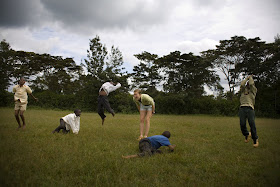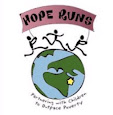Hope Runs: Training Kenyan AIDS Orphans for the Mt. Kilimanjaro Marathon
Claire A. Williams
by Claire A. Williams
USA/Kenya
For my first marathon, I trained in cotton socks. I didn’t know better, and four months of blood blisters punished me for this oversight. My shoes were old, and I never measured the miles I ran. Instead, I relied solely on my own overly optimistic minutes-per-mile calculations on the city streets where I trained. I had no cause, raised no money, and was lucky to have my one and only spectator on race day. Naturally, she forgot to take any pictures.
The second time around, though, I decided things would be different. I would finish in a timely manner and prove not only that I could finish a marathon, but make good time as well. TumainiI got an iPod Nano, a red one at that, which meant that I was supporting charitable causes.
But the best laid plans are rarely the backdrop for success. Thus it happened that in November of 2006, I traveled to climb Mt. Kenya, stayed at a nearby orphanage overnight, and never left. I never climbed the mountain, but in its absence emerged Hope Runs, the organization my traveling partner, Lara, and I started, to train the AIDS orphans of the Tumaini Children’s Center in Nyeri, Kenya, for the Mt. Kilimanjaro marathon on June 24th, 2007.
My marathon training program is wildly different than I originally imagined it would be. Claire with girlsFive days a week, I now run five kilometer loops on the dirt roads near the Tumaini Children’s Center. For the first hour I jog at a near nonexistent pace holding the hands of two-foot-tall primary school girls who run in their church dresses (their only non-school uniforms). For the second hour, I embarrass myself by panting behind the lanky legs of the teenage boys in secondary school. But no matter how fast each orphan runs, his or her feet bear the first successes of our program—a pair of the nearly seven hundred running shoes donated from some of our many generous donors.
The premise of Hope Runs is that of any good organization: by recognizing the importance of connections and creating them, we can transform the lives of the individuals who take part in such endeavors. In practice, Hope Runs: Partnering with Children to Outpace Poverty operates much in the same way that the orphanage began. The Tumaini Children’s Center was conceived in response to the significant number of children in the community in need of food, clothing, and school entrance fees.
As more and more of the eight hundred some children in the nearby community came seeking food, the members of the local parish stepped in to provide. The project soon expanded to house some of the community’s AIDS orphans. In a country with skyrocketing unemployment rates, a living parent hardly ensures immunity from poverty. So while the majority of Tumaini children are orphaned, their diversity also represents the reality of the larger impoverished community in which they live.
At Tumaini (Kiswahili for hope), every building is named something symbolic, and the philosophy of their projects embodies the spirit of Florence's Duomo (use all your resources to build it, and you'll find more) and Shoeless Joe Jackson's Field of Dreams (if you build it, they will come). With each project, Tumaini uses its resources to build the foundation of a new building, and thus continues its growth. In four years, this strategy has produced an orphanage which houses 170 children (and has 130 empty beds), a smaller orphanage of 45 mostly disabled children, a nearly finished community health clinic, and an up and coming old folks’ home.
In its first month, Hope Runs has, in a sense, mimicked the evolution of the orphanage. We started with shoes, moved on to socks, and then slowly began forming partnerships with other non-profits. Now officially able to accept tax-exempt donations, we are pushing full steam ahead to find the massive resources needed to take the kids to a nearby marathon in Kenya in June. Then we’ll use the help of eight Hope Runs volunteers coming to Kenya to launch our first annual 10K race fundraiser at Tumaini.
Lara, Mary, and LucyOver and over again, I am reminded that doing something worthwhile in this world is not just about the money I donate, but rather the connections and experiences I gain in the process. For this very reason, a volunteer's experience in another place on the globe can certainly be worth the cost of the plane ticket to get there. In the long run, such a commitment really can do as much, if not more than simply sending money abroad—it’s this kind of personal involvement that helps transform the nature of our global citizens’ response to growth, aid, and healing change.
The excitement at Tumaini these days is mounting. Nearly twenty of the oldest orphans are officially engaged in marathon training with Lara and me, dozens of older youth run regularly, and over forty younger children never miss a day.
But in our own efforts to encourage such excitement, we can’t help but worry if we’ll really be able to take them to the marathon. We do a lot of finger crossing. Although we’ve all read about the power of endorphins, we’re pretty sure that the real fuel around here is hope.
For more information about Hope Runs, please visit TrippingOnWords.com or HopeRuns.Org.
And follow their activities on Twitter.
[3:14 PM
|
0
comments
]













0 comments
Post a Comment